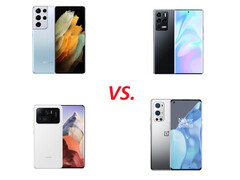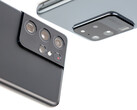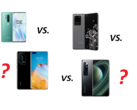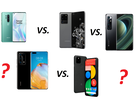Our camera comparison test in the beginning of the year revealed a very close race for the camera throne and a Xiaomi that has joined the camera elite. With the Mi 10 Ultra, the Chinese manufacturer succeeded in setting an example even in the royal discipline of low light photography.
We will now take a look at its successor, the Mi 11 Ultra, which due to one of the largest camera sensors that was ever built into a smartphone was able to conquer the first place in the smartphone ranking by DxOMark. On the other hand, the current camera elite from the Android realm, particularly the Samsung Galaxy S21 Ultra, also offers very good specifications that we summarize in the table below.
| Samsung Galaxy S21 Ultra | ZTE Axon 30 Ultra | OnePlus 9 Pro | Xiaomi Mi 11 Ultra | |
|---|---|---|---|---|
| Back Camera Setup | 108 MP (Samsung HM3, 24 mm, 83°, 0.8 µm, f/1.8, OIS) + 12 MP (120°, 1.4 µm, f/2.2, DPAF) + 10 MP (72 mm, 1.22 µm, f/2.4, OIS, DPAF) + 10 MP (240 mm, 1.22 µm, f/4.9, OIS, DPAF) | 64 MP (f/1.6, OIS, 8K video) + 64 MP (f/2.2) + 64 MP (f/1.9) + 8 MP (f/3.4, OIS) | 48 MP (f/1.8, OIS) + 50 MP (f/2.2) + 8 MP (f/2.4, OIS) + 2 MP (f/2.4, monochrome) | 50 MP (f/2.0, 24mm, 1/1.12", 1.4µm) + 48 MP f/4.1, 120mm, 1/2.0", 0.8µm) + 48 MP (128˚, f/2.2, 12mm, 1/2.0", 0.8µm) |
| Front Camera Setup | 40 MP (1/2.8", f/2.2, AF) | 16 MP (f/2.45) | 16 MP (f/2.4) | 20 MP (f/2.2, 27mm, 1/3.4", 0.8µm) |
| Software Version | RP1A.2000720.012.G998BXXXU3AUF6 | 11.0.0 | 12.2.7.7 | 12.5.7 |
We use all the smartphones in this comparison with their photo, portrait, and night image modes, which are integrated under different names in each of the camera apps of the various manufacturers. All pictures in this comparison are taken with the aid of artificial intelligence software. The camera settings remain in their respective manufacturer defaults. Please also note that most of the pictures are taken using a tripod.
Pictures taken with the smartphone cameras during the day
High-resolution main cameras have become the standard in the current high-end smartphone segment, but these resolutions, some of which are extremely high, are rarely used fully. With the so-called pixel-binning, the actual size of each pixel is increased computationally, allowing it to capture significantly more light and correspondingly also more image information. All the smartphone models in this camera comparison take this route of image processing, so that the resolution of the pictures doesn't correspond to the resolution of the camera sensors.
While the Mi 10 Pro still had some significant problems with backlit shots, the Mi 11 Ultra, but also the Galaxy S21 Ultra, handle such situations extremely well. Here particularly the Axon 30 Ultra leaves something to be desired, and images are generally reproduced by the ZTE flagship with colors that appear too warm. In terms of color accuracy, the other smartphones produce more beautiful and authentic colors, even though the OnePlus 9 Pro shows some slight deficits in the contrast. In terms of sharpness of the images, the OnePlus smartphone is also surpassed by the competitors from Samsung and Xiaomi, and overall we like the pictures taken with the Mi 11 Ultra best. However, we also see some good contrasts, a realistic color reproduction, and many details in the photos taken with the Galaxy S21 Ultra.
In our portrait pictures, the Bokeh effects turned out quite well in all four flagships, but the blurry areas are separated best from the cat in the center by the Mi 11 Ultra. On the other hand, all the test photos show some weaknesses focusing on the central object.
In the area of zoom photography, we purposefully concentrate again only on realistic zoom ranges (5x, 10x), which will also bring an acceptable quality in everyday use. Particularly the 5x zoom range gives some very good results with the Mi 11 Ultra, and the Xiaomi flagship plays in a league by itself here. But the hybrid zoom of the Mi 11 Ultra is also able to keep up surprisingly well with the lossless periscope camera of the Samsung Galaxy S21 Ultra in the 10x zoom range. Overall, the Samsung and Xiaomi flagships perform at eye level, though.
The ZTE flagship shows some strong blurriness in parts of the pictures, and due to the low resolution of the sensor, the details are also slightly reduced. The OnePlus 9 Pro is clearly left behind in this discipline, and because of the low focal distance of its tele lens, it doesn't (even) achieve the zoom quality of an Axon 30 Ultra.
Since Huawei, whose flagships have been the measure of all things in our ultra wide-angle camera test, has not introduced a new flagship with the P50 series yet, this is missing from our comparison. It is therefore difficult to determine a clear winner in this discipline this year. In all four smartphones, the qualitative differences to the main camera are quite pronounced.
The fact that the recordings of the ultra wide-angle camera of the Mi 11 Ultra and Galaxy S21 Ultra cover a noticeably wider angle than those of the competitors from OnePlus and ZTE stands out. Overall, the Galaxy S21 Ultra probably offers the best sharpness levels, and the software does a really satisfying job particularly in the areas on the edges of the images. However, the photos can also appear a bit overly sharpened.
Some visible weaknesses in the photos from the Axon 30 Ultra are apparent particularly outside the center of the image. In addition, the ZTE smartphone illuminates objects clearly too warm and the dynamic could also be better. The same also goes for the OnePlus 9 Pro, but it is not as pronounced. While the pictures from the Mi 11 Ultra also have a relatively low basic sharpness, they offer realistic colors.
Pictures taken with the smartphone cameras at night
In terms of the royal discipline, photography in the dark, Samsung follows the results of the Galaxy S20 Ultra - even though it has only been a few months since its introduction. In low-light recordings, the Galaxy S21 Ultra shows relatively pronounced image noise and a lot of image errors, and the sharpness and exposure are not always optimal either. But the results turn out a lot more attractive when using the night mode. However the predecessor has already proven that the Korean manufacturer is able to continually improve its camera software over a one-year time period.
The most affordable model, the Axon 30 Ultra, does visibly worse, and in low light conditions, neither the sharpness nor the dynamic and exposure look right.
The smartphone that does the best job in the dark is the MI 11 Ultra. Although the Xiaomi flagship overexposes some of the lights, most of our images are reproduced pleasantly sharp and look natural. The noise level is also relatively low.
The evaluation of the OnePlus 9 Pro turns out to be slightly difficult, since already in the photo mode the exposure is automatically adjusted to the level of darkness. This means that there is hardly any noticeable difference to the night mode here.
If you use a lens other than the main camera in the dark, you also need to accept some significant compromises in 2021. The lenses for ultra wide-angle recordings offer significantly less illumination, and the details are also reduced. In this discipline, the ZTE flagship isn't really able to convince, since the image sharpness and illumination are at a comparatively low level. But even the Mi 11 Ultra shows some image noise and blurriness already at dusk. In our test sample, the Galaxy S21 Ultra and the OnePlus 9 Pro tend to be ahead.
As during daylight, the Mi 11 Ultra also sets the standard in zoom pictures here. The Xiaomi flagship is also able to bring solid results using the tele lens in low light conditions. On the other hand, pictures taken with the Galaxy S21 Ultra are disappointing, particularly those that use the 10x zoom range.
Pictures taken with the front cameras of the flagship smartphones
In our opinion, the Galaxy S21 Ultra creates the most attractive selfies, but the front camera of the Mi 11 Ultra also produces beautiful pictures in portrait mode in very good light conditions, although those offer slightly less detail. With its second display on the back, the Xiaomi flagship allows you to take high-quality self-portraits – but currently only in the photo mode, where the pictures also offer the Bokeh effect due to the large sensor. This is a great advantage for friends of selfies, particularly in worse light conditions. The software of the OnePlus 9 Pro interprets the situation using colors that are clearly too cool, and we notice a significant blue tint here.
Verdict on the camera comparison of the flagship smartphones
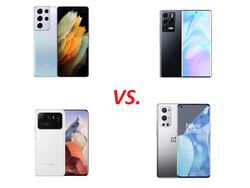
This year – at least in the first half of the year – the Samsung Galaxy S21 Ultra and the Xiaomi Mi 11 Ultra decide the fight for the camera throne among themselves. In daylight, both deliver beautiful sharpness, many details, and saturated colors without looking artificial. Even if we see the Xiaomi flagship slightly ahead in this discipline, the personal taste is probably the deciding factor here.
However, things look different in low light conditions. Here, the noise level of the Mi 11 Ultra is the lowest, and the details in the pictures are most pronounced. As already in the Galaxy S20 Ultra before, in terms of sharpness and illumination the low light results of the Galaxy S21 Ultra are not optimal several months after its release. Due to its relatively affordable recommended retail price of 749 Euros (~$890) and its Trinity camera system, the Axon 30 Ultra is one of the most interesting flagships of the year. However, particularly in the dark, the ZTE flagship is unable to keep up with the photo quality of the camera elite and in the end clearly offers the worst overall package.
In our camera tests, the OnePlus shows itself again and again as a very good allrounder with some weaknesses in the zoom area. While in very good light conditions, the OnePlus 9 Pro is able to convince us throughout, its selfies also appear imbalanced in daylight. In this point, we see the Galaxy S21 Ultra as the strongest (with the front cam), but a Mi 11 Ultra is able to use the qualities of the main camera on the back also for selfies with its small secondary display there.
While this year again, none of the manufacturers delivers the perfect camera package, in the area of photography Xiaomi is closer to this with its Ultra smartphone than the top model of the electronics manufacturer from South Korea.
Prices and Availability
The Xiaomi Mi 11 Ultra is available from several importers in the US. Support of Widevine L1 and LTE band 20, as well as the affordable prices in China, make the CN version of the Mi 11 Ultra very attractive. The import prices of the flagship start at around $962 at Trading Shenzhen, for example, with various firmware versions being available. The unlocked version of the S21 Ultra is available for example from Amazon starting from about $700. The OnePlus 9 Pro is available from many vendors such as Best Buy with prices starting currently at $920. The ZTE Axon 30 Ultra 5G is available for $749 from the ZTE shop.




